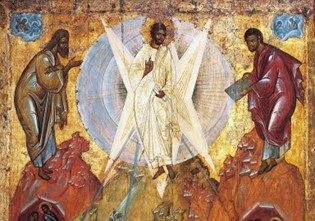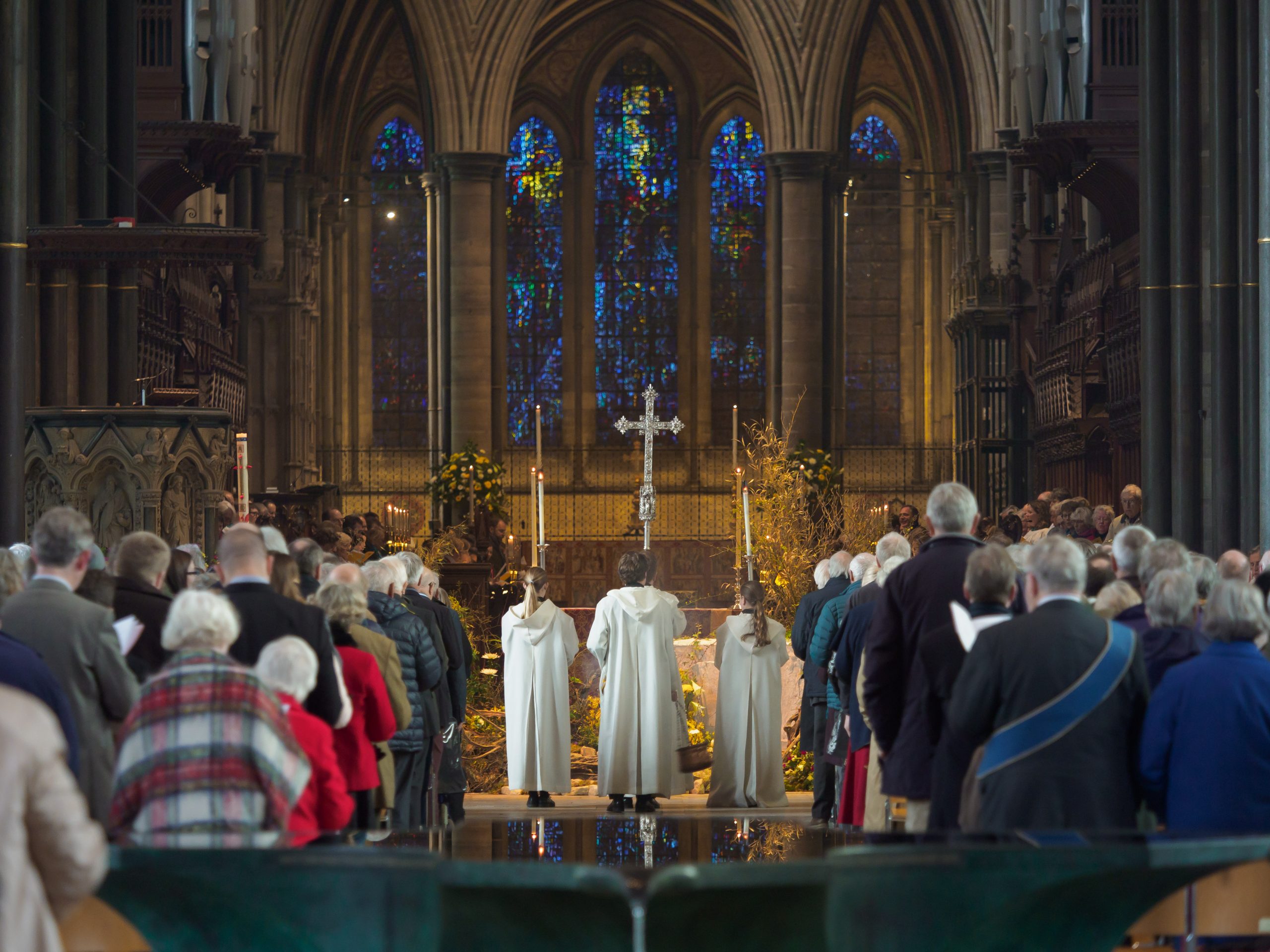Do not be afraid

A sermon preached by The Very Reverend Nicholas Papadopulos
Sunday 19 February 2023, The Sunday next Before Lent
Readings:
2 Peter 1: 16-end
Matthew 17: 1-9
“Do not be afraid”
“But Jesus came and touched them, saying, ‘Get up, and do not be afraid’.”
I hope you all have – or can see – one of these cards? The image that it bears is of an icon written by Theophanes the Greek in the early fifteenth century. It is an icon of the Transfiguration; it now hangs in a gallery in Moscow. Jesus is central. His robes are gleaming white, in contrast with the earthier hues which predominate below. Light streams from him in pointed, star-like rays. Moses is at his left (we know it’s Moses because he is holding the Book of the Law); Elijah at his right (we know it’s Elijah because he sports the ample beard of a prophet); both are standing on the rocky pinnacles of a mountain top. The three disciples are sprawled beneath: Peter on the left, face raised, addressing Jesus; John in the middle, conventionally depicted as a young, beardless man; James on the right, his face covered.
This configuration of the scene is classic in Orthodox iconography and has had an impact reaching far beyond Orthodoxy. Look at the Transfiguration window in the Morning Chapel of the Cathedral and you will see something very similar: Jesus central, Moses and Elijah on the rocky hillock to the left and right, and the three disciples down below.
But what makes the icon of Theophanes stand out is that it has something of the strip cartoon about it. Look carefully at the left of the image, below Elijah’s feet. There’s a hollow in the rock, and in the hollow we can see four figures. Jesus, helpfully distinguishable by his halo, is leading the three disciples up the mountain. Now look at the right, beneath Moses’s feet. There’s another hollow, and another three figures. Jesus is leading the three down the mountain.
Central to the icon is the story that we’ve heard read this morning, the story that appears in the Gospels according to Matthew, Mark, and Luke. Jesus is transfigured and his clothes become dazzling white; Moses and Elijah appear; a cloud overshadows the scene; the disciples fall to the ground. But the icon of Theophanes sets the story in context. Jesus leads the three up the mountain; and he leads them down again. There is a before and an after. Peter, James, and John have to inhabit both the lofty heights and the lower altitudes.
Which is why Peter’s words go unanswered. They have brought down the wrath of two millennia upon his unfortunate head. Anglican sermonizers gather around the Transfiguration texts just as prophets from the Hebrew Bible gather around holy mountain tops, and, like Theophanes, they offer us their interpretations of the story. Peter’s apparently unimpeachable statement “It is good for us to be here…” is challenged by Mark Frank, seventeenth century Canon of St Paul’s, who senses its complacency and its deafness to the struggles of the world below: “Fit it is, and therefore good, to have some fellow-feeling…of others’ miseries, infirmities, and calamities, not good to be here without such compassions”. Harsh, possibly.
But the dwellings are not built and Peter, James and John trudge back down the mountain. Their challenge, perhaps, is to see the ordinariness of the plain in the light of the extraordinariness of the peak.
Their challenge – and ours. For if the Eucharist on the Sunday Next before Lent is a mountain top then from it we can see where the footsteps of Jesus lead: into the wilderness of Lent and into the anguish of Passiontide. “Follow me” says Jesus. It’s been said that we think that’s a good idea. Until we see where he’s leading us.
Almighty Father,
whose Son was revealed in majesty
before he suffered death upon the cross:
give us grace to perceive his glory,
that we may be strengthened to suffer with him
and be changed into his likeness, from glory to glory…
The Collect for today acknowledges the hard road ahead in its three petitions. The first asks that we may be given grace to perceive Christ’s glory, that we may recall that the crucified one is also the glorified one. The preachers gather. John Hacket, seventeenth century bishop of Lichfield, observes “As the face of Christ did bear the greatest share of ignominy at his passion, being buffeted, being spit on, being pricked with thorns, so the honour of the Transfiguration did light upon his face”.
The second petition asks that we may be strengthened to suffer with him. FD Maurice, prophet of the mid nineteenth century, reminds his hearers that when Jesus and the disciples descend the mountain they are confronted with “..tumult and confusion, and that boy with the epileptic fit, [these] represent to us this world in which we are living, full of the strife of tongues, and sorrow, and misery in the midst of it all”.
And the third petition is that we may be changed into Christ’s likeness, from glory to glory. EB Pusey, luminary of the Oxford Movement, exhorts us “…when you return to the world, whether to do or to endure, in life’s daily duties or heavier trials, in childhood’s petty struggles or in manhood’s toils, or the weariness of age and sorrow, may you ever hear that voice of the Father, ‘This is my Son’, do what he saith, hope for what he promiseth, so that when he comes again, of you…it shall be said, in your degree, ‘This is my beloved Son’…”
Neither Frank nor Hacket nor Maurice, nor Pusey can ever have seen or known the icon of Theophanes. Yet his insistence in egg tempera and gold leaf that we ascend the mountain with Christ and descend to the plain with Christ is the same as their insistence in words spoken. Every member of this cloud of witnesses urges upon us the words spoken by Jesus as the glorious vision fades: “Do not be afraid”. They will be among the first words that he speaks to us on Easter morning. As we enter the season of penitence in a world that remains unjust and cruel we need to cling to them: “Do not be afraid”.
Our Transfiguration window was installed in 1920, the gift of Miss Louisa Maude Ottaway. The inscription on the window reads “Dedicated to the praise and glory of God and in thanksgiving for the weekly intercession service held in this chapel”. Intercession is pre-eminently the work of the plain – the hidden, patient holding before God of the pains and sorrows of the world. In this holy place the Transfiguration commemorates that hidden work; may its light illuminate all the paths we tread in the weeks ahead. Amen.




